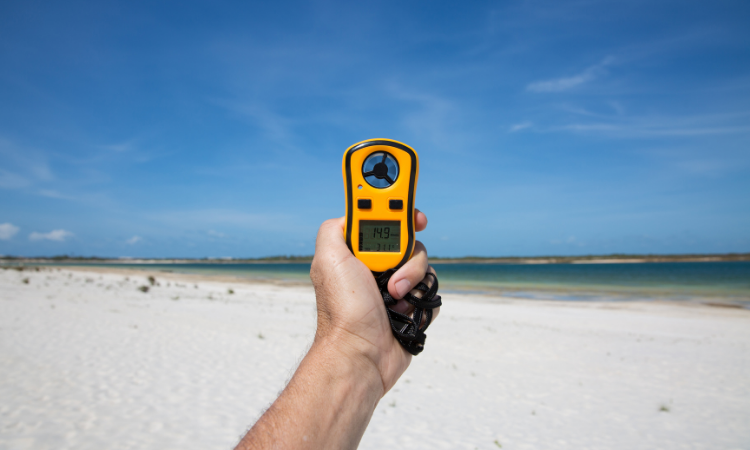Anemometers are popular measuring instruments used to calculate wind speed and direction in a contained or unconfined flow. There are various types of anemometers, including a cup anemometer, vane anemometer, ultrasonic anemometer, and many more. Besides, they also have a variety of industrial applications. Here are the most common types and applications of anemometers.
Major Types of Anemometers
Anemometers offer high precision with low power consumption. Also, they are available in different shapes and sizes in the market. Are you also planning to buy one for measuring wind speed for a specific reason? If yes, then you should know the popular types of anemometers that exist in the industry.
Cup Anemometer
A Cup anemometer is one of the simplest and oldest types of anemometers. Also known as rotational, cup anemometers help to measure the speed and force of the wind. These devices comprise a set of either three or four cups that are arranged on the horizontal arms at one side. These cups spin on a mounted pole by the wind, and as the wind levels increase, the cup spins faster. The instrument then captures the wind speed, which shows on a digital display. Professionals count and calibrate the number of rotations on a digital or analog wind meter to calculate the speed of the wind.
Vane Anemometer
These types of anemometers help to measure the wind speed using the impeller anemometer. They are more accurate than cup anemometers and are often known as windmill or propeller anemometers. Unlike cup anemometers, these types of anemometers need to be parallel to the wind and rotate about a horizontal axis to fetch accurate data.
They count the number of spins per second to calculate the speed of the wind. They are more durable and rugged than other types of anemometers. Besides, they are easy to operate and can also measure other atmospheric parameters. So, if you are looking for a more reliable anemometer device, a vane anemometer is a great option.
Ultrasonic Anemometer
As the name suggests, ultrasonic anemometers use ultrasonic sound waves for measuring wind velocity. This instrument consists of an ultrasonic sound emitter and receiver at the opposite end. The device measures the changing wind parameter on the basis of the acoustic measuring principle. It is even capable of detecting minute values of wind speed.
Moreover, ultrasonic anemometers are weather resistant. These anemometers are of two types, including two-dimensional sonic anemometers and three-dimensional sonic anemometers. Two-dimensional anemometers are used in aviation and navigation. In contrast, the three-dimensional ones help to measure emissions in the power plant industry.
Hot-Wire Anemometer
Also known as constant or thermal current anemometers, hot-wire anemometers comprise four sensors placed in a square model. They can measure both pressure and speed of the wind. These anemometers use the principle of an electrically heated wire situated in the gas stream. The heat flows from wire to gas, and thus, the temperature of the wire reduces. Also, it changes the wire resistance, and this change of resistance is a major parameter to measure the flow rate of air. You can find these types of anemometers in the air-conditioning, ventilating, and heating industry.
Laser Doppler Anemometer
Laser Doppler anemometers use the doppler effect to measure the instantaneous velocity of airflow. These devices are non-intrusive without the need for calibration, and they can even measure flow reversals and high resolutions. They have an advantage as they don’t disturb the fluid’s path. As mentioned before, the instrument uses the doppler shift effect, which is a reliable method to determine the wind speed. They usually find their applications in high-tech sectors like jet engines and river hydrology.
Common Applications of Anemometer
Now that you know the popular types of anemometers available in the market, let’s have a look at their common use. Here are some popular applications of anemometers
- Like a professionalEnvironmental meter 5 in 1 tool, anemometers are used to measure air velocity, temperature, and chill temperature.
- Anemometers help to measure the gas flow in turbulent flow conditions
- Weather stations use anemometers to know the change within weather patterns
- Skydivers use this device to measure the velocity of the wind.
- You can also find the use of this instrument in aerodynamics to measure airspeed.
- Anemometers can measure the airflow in air conditioners, ventilation units, and heating systems.
- The RC plane and drone users also use this measuring tool to verify the weather conditions before testing their instruments.
- Long-range shooters and pilots also use anemometers.
Key Takeaway!
Hopefully, now you know the major types of anemometers and their significant applications. We can’t say which type of anemometer is the best because they all are efficient in their own ways and functions. Moreover, these different types of anemometers suit specific needs and applications. So, buy the most suitable anemometer for your work.


